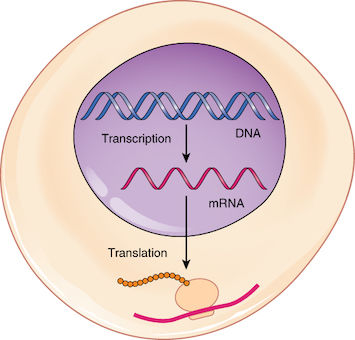Transcription is the synthesis of a messenger RNA (mRNA) molecule from the DNA sequence of a gene.
This process takes place in the nucleus of the cell. At first, the DNA double helix separates, allowing the formation of a strand of mRNA complementary to one of the two strands of DNA. Complementary pairs form between DNA and mRNA: cytosine with guanine and, unlike complementary pairs of DNA, adenine binds with uracil. Once the mRNA molecule is completed, it detaches and crosses outside the nucleus into the cytoplasm. The next step is the translation of this mRNA molecule.
Translation is the making of a protein from the nucleotide sequence of an mRNA molecule. When this occurs, the genetic code is converted into amino acids.
Once transcription is complete, the mRNA released in the cytoplasm joins a ribosome, the organelle responsible for translation. A second type of RNA is required to perform the translation, this is the transfer RNA, also called tRNA. This molecule has two ends, each having their own function. The first is responsible for the transport of the amino acid designated by the mRNA codon. The second includes a triplet which is complementary to the mRNA codon.
During translation, the ribosome travels along the mRNA strand exposing its codons one by one. Thus, the tRNA molecules supply the amino acids in the order indicated by the mRNA sequence. The ribosome then takes care of "attaching" the amino acids together to form a polypeptide chain, i.e. a protein.
Mutations are changes in the DNA sequence of genes. There are 4 types: substitution, displacement, insertion, or loss of one or more nucleotides.
Mutations may have no impact on the body. However, most of the time, organisms are negatively affected by these mutations as the structure and function of some proteins are altered. In rare cases, mutations can be beneficial to certain organisms, giving them new characteristics that allow them to be better adapted to their environment.
Very often, mutations occur unexpectedly during DNA replication before mitosis and meiosis. The cell usually repairs these replication errors, but sometimes certain mutations are so significant that they alter the cell's genome permanently and irreversibly, thus disrupting protein synthesis.
Mutations may take place during the formation of gametes, so that the mutations will be transmitted to an individuals’ descendants. This phenomenon generates observable genetic variations between populations and, therefore, contributes to genetic diversity. However, the passing of harmful mutations is the source of transmission of several hereditary diseases, which can lead to malformations or chronic diseases.
Certain environmental factors, called mutagens, can increase the frequency of mutations. Ultraviolet radiation, ionizing radiation, some pesticides, and cigarette smoke are examples of mutagens.
